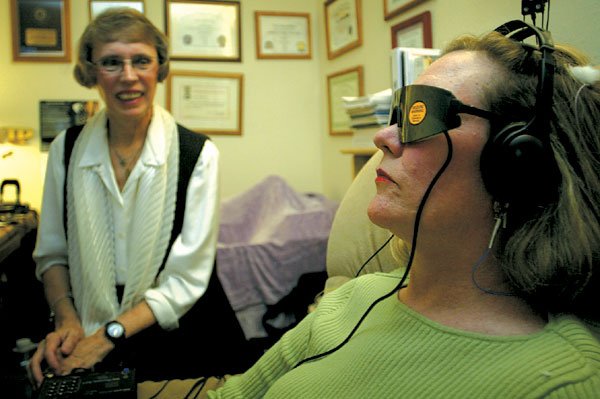Gilroy
– It might just be the therapy of the future. With approximately
1,000 doctors in the country practicing it and only a handful of
them located in the South Bay Area, neurotherapy is a cutting-edge
technology.
Gilroy – It might just be the therapy of the future. With approximately 1,000 doctors in the country practicing it and only a handful of them located in the South Bay Area, neurotherapy is a cutting-edge technology.
For Gilroy psychologist Dr. Viera Pablant, the therapy was a long-awaited cure for her debilitating migraines, after trying everything she knew to get rid of them. She drank plenty of water, took estrogen, got enough sleep and watched her diet, which helped reduce her migraines from twice a week to once a month. But that wasn’t enough.
“They interrupted with my life,” she said.
In 2003, after four years of suffering, she decided to try something new. She slipped on glasses and earphones that produce sound and flashing lights, meant to train her brainwaves to follow a similar pattern. The treatment is called audio-visual entrainment, a kind of light and sound therapy.
Now, as soon as she starts to feel a headache coming on, she slips on the AVE unit, even administering the therapy once while flying on a plane.
“I have not had one migraine,” Pablant said. “To be a whole year without one is like ‘wow.'”
She was sold.
She started offering audio-visual entrainment to her clients, in combination with the neurofeedback and biofeedback that she already provided. Together, she calls the three, “neurotherapy,” a treatment meant to safely change the natural activities of the body and brain.
“Nothing hurts and there are no side effects. That’s the beauty of it,” she said.
Her patients come mainly from four counties: south Santa Clara, San Benito, Santa Cruz and north Monterey.
Pablant, 59, uses the treatment most often with children who are diagnosed with attention deficit hyperactivity disorder. The typical treatment for ADHD is medication, such as Ritalin, which sometimes carries side effects, she said. Neurotherapy is a drug-free alternative that teaches kids to alter their brainwaves.
Pablant has observed its effectiveness.
“All of the sudden they become mellow kids that are pleasant to be with,” she said. “It’s an amazing change when it happens. They become self-motivated. Their parents don’t have to be on top of them to do their homework.”
That doesn’t mean Pablant shrugs off drugs all together. Instead, she may use a variety of treatments depending on the case.
Neurotherapy can treat a number of ailments besides migraines and ADHD, including anxiety, depression, addictions and sleep problems.
One recent day, Pablant hooked patient Ceci Cox, of San Jose, up to a computer by first rubbing a special cream on her scalp and earlobes to enhance receptivity of the sensors to the brain’s electricity.
“Electricity of the brain is very minor,” Pablant said, as she attached sensors to two points on Cox’s scalp and both of her earlobes, linking her to the computer. Suddenly, the computer screen lit up with Cox’s brain activity. On one side of the screen was an electroencephalogram, or EEG. In the background, the sound of Cox’s brainwaves played eerily on a stereo, sounding like music from a science-fiction movie.
For the biofeedback portion, Pablant taped wires to five of Cox’s fingertips to measure her heartbeat, temperature and skin’s resistance to electrical conductivity (galvanic skin response).
Cox’s challenge was to calm her mind.
“I would like to be able to meditate,” she said. “I’ve always had a problem with sleep, not being able to turn my brain off.”
With the help of neurotherapy, she is trying to learn to increase her alpha waves, which signal a state of relaxed wakefulness.
Pablant pulled up a series of pictures, puzzles and games on the computer which Cox controlled, or played, with her brainwaves. One picture was of a dolphin leaping from a pool of water. As Cox began to relax, the image became clearer, and she could tell it was a dolphin. The challenge was to keep the full image on the screen for as long as possible by emitting the right brainwaves. In this way, she was training her brain to relax.
“They do all of the work themselves,” Pablant said. “It’s not easy to change EEGs.”
Cox would also like to improve her memory as she ages. In children, neurotherapy can increase their IQs by up to 50 points, Pablant said.
It will take about 40 of the 30-to-40-minute sessions – about a year’s worth – to achieve the results Cox wants and make them lasting. In addition, Pablant lets patients borrow AVE glasses and use them for 30 at-home sessions.
The combination of neurofeedback, AVE and biofeedback helps patients change their old way of functioning – forever, Pablant said. Once the brain has retained a certain mental state, it’s permanent, like learning to ride a bike, she said.
“Meditators achieve the same results. But it takes them 10 years,” Pablant said.
So why aren’t more therapists using neurotherapy? The technology is expensive and training-intensive, Pablant said.
She has taken several classes in neurotherapy to the point where she now is an assistant teacher, has invested up to $25,000 in equipment and has experimented with the complicated gadgetry on family and friends until she felt comfortable enough to use it with patients.
More importantly, the process is not FDA approved. However, several insurance companies recognize it as a treatment and will cover her patients’ visits, she said.
Pablant understands people’s skepticism, because at first, she doubted it herself. But after a year of being migraine-free, the evidence is convincing, she said.
“I’m going to stay with it, because it’s effective.”
For more information, visit www.amicitas.com or www.neurofeedback-institute.com.












